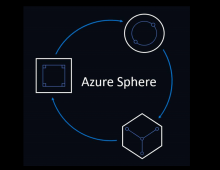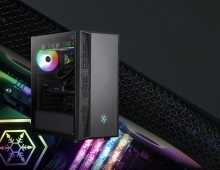
Arduino Launches New Dev Platform at CES 2020
Arduino announced a new low-code Internet of Things application development platform at CES 2020 in Las Vegas. It also introduced the low-power Arduino Portenta H7 module, a new family of Portenta chips for a variety of hardware applications.
Millions of users and thousands of companies across the world already use Arduino as an innovation platform, and the new simple IoT application development platform is designed for professionals in traditional sectors aspiring for digital transformation through IoT.
Combining a low-code application development platform with modular hardware makes tangible results possible in just one day. This means companies can build, measure, and iterate without expensive consultants or lengthy integration projects.
Built on Arm Pelion technology, the latest generation of Arduino solutions brings users simplicity of integration and a scalable, secure, professionally supported service.
At CES 2020, Arduino announced the powerful new Arduino Portenta family. Designed for demanding industrial applications, AI edge processing and robotics, it features a new standard for open high-density interconnect to support advanced peripherals. The first member of the family is the Arduino Portenta H7 module – a dual-core Arm Cortex-M7 and Cortex-M4 operating at 480MHz and 240MHz, respectively, with industrial temperature-range (-40 to 85°C) components. The two cores communicate via a Remote Procedure Call mechanism that allows calling functions on the other processor seamlessly. Both processors share all the in-chip peripherals and can run:
- Arduino sketches on top of the Arm Mbed OS
- Native Mbed applications
- MicroPython / JavaScript via an interpreter
- TensorFlow Lite
It also features a crypto-authentication chip and communications modules for WiFi, Bluetooth Low Energy and LTE, as well as Narrowband IoT.

You can also connect to the Portenta H7 an external monitor to build your own dedicated embedded computer with a user interface. This is possible thanks to the processor's on-chip GPU, the Chrom-ART Accelerator. Besides the GPU, the chip includes a dedicated JPEG encoder and decoder.
The Portenta family also adds two 80 pin high density connectors at the bottom of the board. This ensures scalability for a wide range of applications by simply upgrading your Portenta board to the one suiting your needs.
The onboard wireless module allows to simultaneously manage WiFi and Bluetooth connectivity. The WiFi interface can be operated as an Access Point, as a Station or as a dual mode simultaneous AP/STA and can handle up to 65 Mbps transfer rate. Bluetooth interface supports Bluetooth Classic and BLE. It is also possible to expose a series of different wired interfaces like UART, SPI, Ethernet, or I2C, both through some of the MKR styled connectors, or through the new Arduino industrial 80 pin connector pair.
The board's programming connector is a USB-C port that can also be used to power the board, as a USB Hub, to connect a DisplayPort monitor, or to deliver power to OTG connected devices.
The Arduino Portenta H7, now available for pre-order on the Arduino online store, is priced from US$49.99 to $99.99. Its estimated delivery date is late February.
The default Portenta H7 using the codename Arduino Portenta H7-15EUNWAD. The board comes with:
- 8MB SDRAM
- 16MB NOR Flash
- 10/100 Ethernet Phy
- USB HS
- NXP SE050C2 Crypto
- WiFi/BT Module
- Ceramic Antenna
- DisplayPort over USB-C
If you need more memory, Portenta H7 can host up to 64 MByte of SDRAM, and 128 MByte of QSPI Flash. You can also order it with an external UFL connector for adding a higher-gain antenna to the board. Decide between crypo-chips from Microchip and NXP.
Portenta H7 TECH SPECS| MAIN PROCESSOR | STM32H747XI dual Cortex®-M7+M4 32bit low power Arm® MCU |
| SDRAM | 8-64 MByte option |
| QSPI FLash | 2-128 MByte option |
| Ethernet | 10/100 Phy option |
| Wireless | BT5.0 + WiFi 802.11 b/g/n 65Mbps option |
| Crypto Chip | ECC608 or SE050C2 (Common Criteria EAL 6+) option |
| DISPLAY CONNECTOR | MIPI DSI host & MIPI D-PHY to interface with low-pin count large displays |
| GPU | Chrom-ART graphical hardware Accelerator™ |
| TIMERS | 22x timers and watchdogs |
| UART | 4x ports (2 with flow control) |
| SD Card | Interface for SD Card connector (through expansion port only) |
| OPERATIONAL TEMPERATURE | -40 °C to +85 °C (excl. Wireless module) / -10 °C to +55 °C (incl. Wireless module) |
| POWER | Through USB-C connector or LiPo battery (integrated charger) |
| CURRENT CONSUMPTION | 2.95 μA in Standby mode (Backup SRAM OFF, RTC/LSE ON) |
| USB-C | Host / Device, DisplayPort out, High / Full Speed, Power delivery |
| MKR HEADERS | Use any of the existing industrial MKR shields on it |
| HIGH DENSITY CONNECTORS | Two 80 pin connectors will expose all of the board's peripherals to other devices |
| ESLOV CONNECTOR | Arduino's open connector standard for self-identifiable hardware |
| CAMERA INTERFACE | 8-bit, up to 80 MHz |
| ADC | 3× ADCs with 16-bit max. resolution (up to 36 channels, up to 3.6 MSPS) |
| DAC | 2× 12-bit DAC (1 MHz) |




















